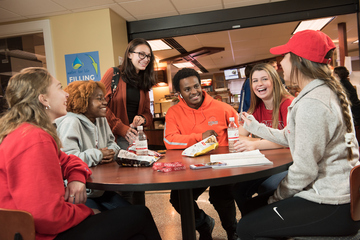
08/20/2020
SUNY Cortland students love many things about their university, including their quality of life and safety on campus, the accessibility of faculty and Cortland’s dedication to sustainability.
So it’s no surprise that SUNY Cortland was named to the Princeton Review’s 2021 list of the “Best Colleges Region by Region” for the Northeast.
The Princeton Review looked at factors including academics, admissions selectivity, financial aid, fire safety, quality of life as well as its “Green” metric that examines the performance of colleges and universities as environmentally aware and prepared institutions.
Specifically for academics, this ranking considered how many hours students typically spend studying outside the classroom, student assessment of faculty, class size and the amount of class discussion, among other factors. Student reaction to the questions “Are your instructors good teachers?” and “Are your instructors accessible outside the classroom?” were also weighed.
In addition to strong relationships between faculty and students, SUNY Cortland is continuously adding new majors and certifications, including an online master’s in literacy education, a major in media production, a master’s degree in athletic training and a bachelor of fine arts degree program in musical theatre.
In the last year, some of SUNY Cortland’s academic programs have been ranked among the nation’s best. The online master’s program in sport management was named top in the Northeast by Intelligent.com. The Communication and Media Studies Department was ranked No. 3 in the state by Zippia.com. SUNY Cortland’s master’s degree in coaching was placed at No. 5 in the nation by TheBestSchools.org.
The academic rigor of SUNY Cortland’s programs leads to results in the job market for young alumni. Zippa.com ranked SUNY Cortland No. 5 in the nation on its 2020 list of “Best Public College in Each State for Getting a Job.”
SUNY Cortland was rated as an 88 out of 99 on the Princeton Review’s admission selectivity scale, which measures standardized test scores, class rank and GPA of incoming students as well as the percentage of applicants accepted.
The study also looks at how much colleges and universities award in financial aid and how satisfied students are with that aid. In addition to federal and state financial aid programs, SUNY Cortland offers grants, work study and scholarship opportunities to further help students and families afford college costs. Each year, the university provides more than $1 million in scholarship assistance to more than 1,000 students.
Quality of life was measured by looking at the safety and location of each campus, the comfort of dorms, the quality of food, the friendliness of fellow students and the strength of a school’s relationship with its local community.
Safety is a top priority at SUNY Cortland and the university has been recognized many times in this field. Safewise.com placed Cortland on its annual ranking of the safest college towns in America in 2017, 2018 and 2019. YourLocalSecurity.com named Cortland the safest college environment in New York state in 2019. Also in 2019, SUNY Cortland’s University Police Department recorded its lowest crime rate in 43 years.
Students enjoy a variety of dining options on campus. The recently renovated restaurants in Corey Union earned a silver medal from the National Association of College and University Food Services.
Finally, The Princeton Review examined the sustainable quality of life for colleges and universities, as well as how well each school is preparing students for employment in a clean-energy economy. SUNY Cortland has a long tradition of being one of the most green campuses in the nation, having been named to the Sierra Club’s “Cool Schools 2019 Ranking” as well as the Sierra Club’s rankings in 2017 and 2018. The university has also received a prestigious gold rating from the Sustainability, Tracking and Assessment Rating System (STARS), the only SUNY comprehensive college to do so.
The Princeton Review selected 655 colleges from around the world for its annual report, breaking them into five zones: Northeastern, Southeastern, Midwestern, Western and International.